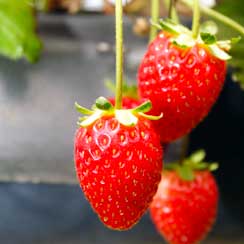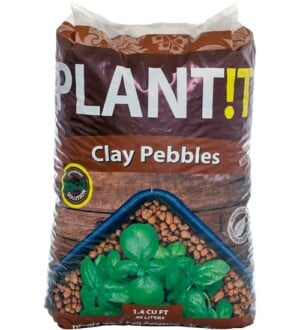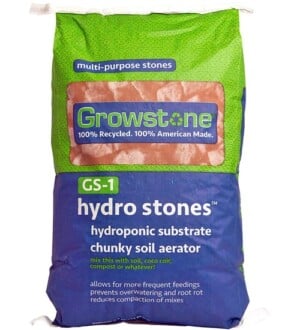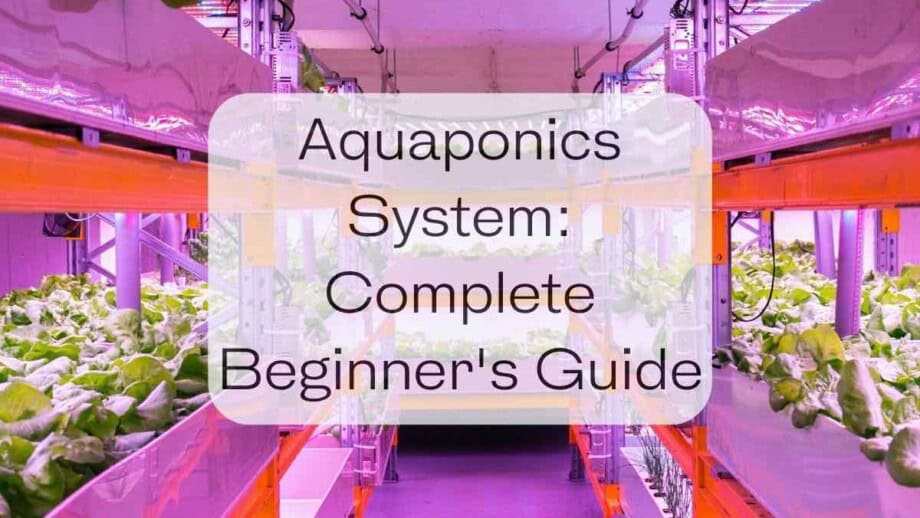Indoor and backyard aquaponics system combines the craft of hydroponic growing with aquaculture, the art of keeping fish.
The water in which the fish live, along with the fish-produced waste, eventually ends up nourishing garden plants. It’s then recycled to the fish tank. The plants get the nutrients they need and the fish get fresh, recycled water.
In return, the savvy gardener gets organic vegetables for salads and fish for the grill.
This is the simplistic explanation of aquaponics gardening. In practice, it’s a balancing act that supports all its living components, including the microscopic life that facilitates the natural conversion of fish-produced waste into usable, beneficial nutrients for plants.
If you’ve been wanting to learn more about aquaponics systems, then this guide is perfect for you! Read on to learn everything you need to know about aquaponics system.
If you’re growing indoors, hydroponics is the ticket to impressive growth and yields.
IMPRESSIVE YIELDS!
Hydroponics Gardening
What is Aquaponics?
Aquaponics is a mix of aquaculture which involves raising fish and hydroponics which is a method of growing plants in a nutrient solution.
With the help of good bacteria, aquaponics systems let you grow plants and raise fish at the same time. All of these parts complement one another in an aquaponics setup.
You can grow organic food with aquaponics in a self-sustaining garden with limited space and resources.
In an aquaponic system, the route from fish to plants is populated by a filter of beneficial bacteria that converts the fish waste — mostly harmful ammonia and nitrites — into nitrates and other nutritional elements that plants thrive on.
The plants take up this natural fertilizer and return waste-free water back to the fish. The cycle repeats, reusing the self-contained system’s water over and over again, once the balance is achieved.
It’s like learning to ride a bike. A steady, guiding hand is needed at first. Once the system gains equilibrium, it rolls on without much help.
It’s no wonder that commercial-scale aquaponics farming is becoming at a time when water is in short supply. Not surprisingly, the systems and techniques utilized by large scale growers were first developed by small enthusiasts often working right from their backyards.
What Components Make Up an Aquaponics System?
While the principles are easy to understand, their application, even for small home aquaponic systems, can be made as simple or as complex as you like. Best to start simple.
Basic equipment includes tanks and grow trays and the plumbing to connect them, as well as pumps and drains. Unless you’re growing outdoors in a temperate climate, you’ll need to provide artificial light and heat.
There are non-sustainable aspects to aquaponics, namely daily fish food, the electricity to run the pumps and the lights, and the water required to replace loss from evaporation and other factors (hopefully not leaks).
Then there are the tanks and the pipes. These are one-time purchases. Once established, growing this way is sustainable and earth-friendly, using less fuel and chemicals, not to mention water, than conventional gardening.
Establishing a homemade system doesn’t have to be expensive. Many do-it-yourselfers save money by scavenging plastic barrels, stock troughs, or recycled bathtubs to cut costs.
Why Consider Aquaponic Gardening?
Aquaponics, no matter the scale, makes for a dramatically more-efficient garden. Done right, it yields both fish and vegetables at impressive rates, rivaling the most intensive, stand-alone hydroponic and aquaculture operations.
Better yet, it solves most problems experienced by hydroponic and fish-raising systems, namely providing a constant, balanced supply of plant nutrients without additional fertilizer while disposing of the wastes that accumulate from fish and food in aquaculture tanks.
Benefits of an Aquaponics System
- One of the best benefits is that aquaponics systems make it possible to have a food production system that’s actually sustainable.
- Protects the environment by using less water and generating less waste and runoff. Instead, the self-contained system recycles its water, removing potential pollutants along the way. Very little water is wasted. Large-scale aquaculture growers are said to use 2% of the water consumed by conventional farming.
- No fertilizer required. With the help of beneficial bacteria, it’s produced — organically — from fish waste, cutting out fertilizer expenses.
- Easily adapted for home and small-scale needs. It also can be sized for continuous, economically sound, commercial produce production.
- Daily tasks, harvesting, and planting are labor-saving and can be done by most people easily.
- Yields both nutrient-packed carbohydrates and protein in the form of vegetables and fish.
- Fish are not exposed to mercury, PCBs, or other pollutants. No antibiotics or growth hormones of the type used in commercial fish farming are required.
- Makes it easy to grow organic by prohibiting the use of pesticides or herbicides that would harm the fish in the system.
- Fast, healthy growth discourages insect problems, even in greenhouses.
- No weeding required.
- Gardening beds are most frequently placed above fish-raising tanks, bringing them up to an easy-to-work height. No bending or stooping is required.
- Allows for local, small farm growing, even out-of-season. And while local out-of-season growing requires energy in the form of heat and light, it doesn’t compare to the fuel gobbled up by trucks, tractors, and other farm equipment as well as that needed for long shipment and refrigeration of commercially grown produce.
Principles of Aquaponics
Nitrification
The chemistry behind the conversion of fish waste, uneaten food, and other organic matter from the fish tanks into nutrients plants can use — the nitrogen cycle — is somewhat complicated but worth understanding at a practical level.
Fish excrete ammonia through their gills. Some ammonia is also created in the fish tank as aquatic plants and uneaten food decays but most come from the fish themselves.
Ammonia is a source of nitrogen, something plants need. Its conversion requires two kinds of bacteria. The first, Nitrospomonas sp., converts the ammonia to nitrites (NH3). The nitrogen in nitrites isn’t usable by plants. And even at low levels, nitrites are toxic to fish.
A second bacteria Nitrospira sp. converts the nitrites to nitrates (many sources credit the Nitrobacter sp for this conversion) a form which can be used by plants who then remove it from the water. The water is returned to the fish, waste, and ammonia free.
The nitrifying bacteria that facilitate the conversion process occur naturally and will multiply in the system as conditions come into balance. They can also be introduced into systems. Once established, they live in the grow trays, in the growing medium, and in the pipes that conduct the water to the grow beds, visible as slime known as biofilm. It’s in this film that the bacteria do their thing.
Intensive growers and those using large volumes of water add a third vessel to their fish tanks and grow trays known as a sump, a place where bacteria can multiply and convert waste. Water from one or multiple grow beds first goes to the sump before it returns to the fish tanks.
As in soil, numerous factors are at play to create the best conditions for plants, fish, and conversion bacteria.
Maintaining Proper pH Levels
Maintaining proper pH levels in the water is critical. As gardeners know, most plants prefer a slightly acidic pH. But fish prefer a slightly alkaline pH, as do the beneficial bacteria. This requires a compromise, a pH of 6.8 – 7.2 to keep all three happy.
Growers need to keep a close eye on the pH level of the water in their system, especially at first. A pH reading of 7.0 and higher is required in a new system that is “cycling,” the period in which the nitrifying bacteria are establishing themselves before the addition of plants.
Once plants are added to the system, the pH naturally declines. If the pH is too acidic, falling below 6.8, the waste-conversion process will slow, allowing nitrites back into your fish tank.
Because pH levels vary naturally, growers need to periodically check for ammonia and nitrite levels in their systems. Some types of fish (tilapia) are more tolerant of less-than-perfect water conditions than others. But all do best when conditions are ideal.
Aeration
The movement of fish tank water so that it may absorb oxygen is also necessary. This is usually accomplished by the water circulating back to the fish tank. More intensive fish raising can require supplemental oxygenation from an aeration device like those used in aquariums.
Different Types of Aquaponic Systems
Before choosing a system, consider where it will be located. Indoors (garage, basement, other)? Outdoors? In a greenhouse? Consider the availability of water and electricity. Will you need to light and heat your aquaponic garden? Most likely, especially for year-round operations, you will.
There are many different types of aquaponics systems being used today, including many DIY aquaponics systems. But let’s look at some of the most popular kinds that you’re likely going to come across:
Media Bed Aquaponics System (Flood and Drain System)
Media-Based, also known as Flood-and-Drain, is the most prevalent aquaponics system, favored by DIY aquaponics lovers, backyard home systems, and commercial farms.
In a media-based system, the crops are planted in a grow bed or container that is filled with grow media, which is typically gravel, lava rock, or clay pebbles. In order for the plants to access the nutrients, the grow bed is periodically flooded with water from the fish tank through a bell siphon. After that, the water returns to the fish tank and a new cycle starts.
In the grow bed, all waste is broken down. Worms are sometimes put in the grow medium to help break down the waste. The media-based filter has the fewest parts and doesn’t need extra filtration, which makes it easy to run and manage. PLANT!T is light in weight, does not compact and is completely reusable!
A FAVORITE!
Clay Pebbles

Deep Water Culture (DWC)
The deep water culture is also known as the raft system or the floating system.
In this type of system, rafts made of polystyrene or foam board float on top of the nutrient-rich water as it circulates through the lengthy canals at a depth of typically 7 to 8 inches.
Plants are grown on the raft boards, which have holes that are filled with net pots. Plant roots dangle in nutrient-rich, oxygenated water, absorbing oxygen and nutrients as they grow rapidly.
The water that is rich in nutrients travels in a continuous cycle from the fish tank to the filtration process, then to the raft tank where the plants are grown, and then finally back to the fish tank where it began. The raft tank is usually separate from the fish tank.

Nutrient Film Technique (NFT)
The Nutrient Film Technique (NFT) is a hydroponic growing method that has been adapted to aquaponics due to its simple, yet effective, design that functions well in certain environments.
Plants are grown on long, narrow channels in the NFT method. The roots of the plants are constantly supplied with water, nutrients, and oxygen by a thin film of water that flows continuously down each channel.
The NFT system works similarly to the raft system in that water is pumped out of the fish tank, through filtration components, into the NFT channels where plants are grown, and then back into the fish tank.
In NFT, there isn’t enough surface area for the good bacteria to live, so they need a separate biofilter.

Recommended Plants for Aquaponics System
Not all plants take well to this type of growing. Generally, the same vegetables that do well in hydroponic systems can be grown in aquaponic setups. These include lettuce and other leafy greens, tomatoes, cucumbers, strawberries, and herbs such as basil, mint, watercress, and chives.
Root vegetables, including carrots and turnips, can be grown if the planting media is deep enough. They’re difficult to raise in floating raft-type setups where they often produce strangely shaped, twisted roots. A superior product that has been double washed and aged for at least 18 months.
READY TO USE!
CocoGro
What Fish Are Best for Aquaponics?
Aquaponic gardeners, vegetarians, and not, often do not raise fish for consumption. The fish’s only role is to provide fertilizer.
When raising fish for consumption, consider their hardiness, rate of growth, water temperature requirements (compared to the temperature needs of the vegetables you want to grow, feed consumption, and ease of preparation (such fish as perch and carp are well-built on bones that make cleaning them difficult). The fish frequently raised in aquaponics, both for food and not:
Tilapia
Tilapia are currently the most popular and easily raised of food fishes. They reach harvest size quickly and will tolerate a wider range of pH and water temperature levels (60 to 75 degrees and above) than most fish.
Tilapia are omnivorous and usually won’t harass or feed on their smaller brothers. The firmness of their flesh and mild taste have made them popular with chefs. They’re especially good grilled. Some states ban certain types of tilapia in an effort to keep them out of freshwater lakes and streams.
Catfish
Catfish are the leading, commercially raised freshwater fish. They are hardy, suitable to warm-water conditions up to 80 degrees, and resistant to many diseases and parasites that can appear in self-contained tanks. Because catfish crowd the bottom of tanks, they are usually raised at density levels less than those recommended below.
Trout
Trout are a favorite food fish but are more difficult to raise. They require relatively cold water temperatures (55 degrees or less). Water this cold will affect the growth of vegetables. Lettuce and other cool-weather crops will grow slowly with water at this temperature.
Tomatoes, cucumbers, squash, and other warm-season crops aren’t suited for systems raising trout or other cold-water species.
Carp
Carp are hardy and adaptable to a wide range of conditions. This makes them a good choice for beginners. Not always a favorite food fish, the carp you grow in clean, aquaponic water don’t have the muddy taste of carp taken from rivers and lakes. Properly filleted, carp makes for excellent tacos and sandwiches.
Goldfish
Goldish, a cousin to the carp, is a popular, non-harvestable choice for home systems. Hardy and easy to obtain, goldfish and their larger relative Koi fish, add decorative touches to your system. Both are good choices for beginners.
Other fish used in aquaponics include perch, bass, bluegills (sometimes grown in conjunction with catfish), and various types of non-fussy aquarium fish such as guppies.
It’s important to calculate the density of fish to the water in your tanks. Too few fish means less nourishment for your plants. Too many can starve the fish of oxygen and otherwise stress them.
The rule of thumb suggests a quarter pound of fish or less per gallon of water. Higher densities — a half pound of fish to a gallon of water — should be attempted only by experienced growers. A 100% recycled growth medium that's perfect for vegetables, herbs and flowers.
100% RECYCLED
Hydro Stones (GS-1)
Tips & Techniques for Aquaponics Systems
- When adding new fish to the system, quarantine them first for at least three to five days to make sure they won’t introduce disease into your fish tanks.
- Do not use copper tubing or plumbing in your setup. Copper is toxic to fish.
- Fish are sensitive to rapid temperature changes. Keep water temperatures in fish tanks as constant as possible.
- Don’t expose outdoor fish tanks to the sun which can cause rapid water temperature fluctuations.
- Provide shade or cover to prevent algae from growing in the tanks.
- Heating the water in your fish tank to keep it at the proper temperature can be the most power-consuming facet of your aquaponic system. Insulate as possible. Outdoor systems placed against the house or other buildings help slow heat loss.

More Resources on Aquaponics Systems
Here’s a good video introduction with a somewhat commercial slant from Purdue University Extension, the National Oceanic and Atmospheric Administration, and Sea Grant College Illinois-Indiana. Texas A&M’s site, Growing Fish and Plants Together (PDF), is geared toward smaller, home operations.
The United States Department of Agriculture has a long list of informative links that cover various aspects of aquaculture and soilless farming.
Looking for ideas on how to design your system? Try here.
The definitive resource for growers continues to be Sylvia Bernstein’s Step-By-Step Guide To Raising Vegetables and Fish Together.













